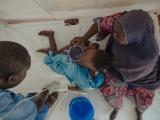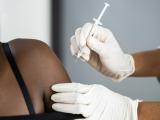Jan 9, 2013 (CIDRAP News) – The death toll in Haiti's cholera epidemic is approaching 8,000, and more than 6% of Haitians have had the disease since it invaded the country in October 2010, according to reports released this week.
In a Jan 7 cholera update, the Pan American Health Organization (PAHO) said fatalities in Haiti reached 7,912 as of Dec 31, out of 635,980 cases and 350,679 hospitalizations. The case-fatality rate is 1.2%.
The tally of cases and deaths was lower in 2012 than in 2011, but the epidemiologic patterns were similar in both years, with peaks occurring during rainy periods from May through July and in September and October, PAHO said.
The cumulative attack rate in the epidemic reached 6.1% by October 2012, according to a new analysis of surveillance findings during the first 2 years of the epidemic. The study by an international team was released today by the New England Journal of Medicine.
The authors examined data collected up through Oct 20, 2012. At that point the case count was 604,634, and the death toll was 7,436. Haiti accounted for 57% of all cholera cases and 53% of cholera deaths reported to the World Health Organization (WHO) in 2010, the report says. For 2011 the respective figures were 58% and 37%.
Within days after the epidemic began, the Haitian government launched a special surveillance effort, the National Cholera Surveillance System (NCSS), according to the report. Using a broader case definition than the WHO definition, the system counted cases of watery diarrhea in persons of any age, rather than excluding cases in children under age 5.
Children in that age-group accounted for 78,938 cases (13.1% of the total), 34,394 hospitalizations (10.4%), and 580 deaths (7.8%), the authors found.
Their data revealed five distinct peaks in epidemic activity over the 2 years: a short burst in late October 2010 that was limited to two departments (provinces), a taller, broader peak from mid-November 2010 through mid-February 2011, a smaller spike in June and July 2011, a still smaller one in the fall of 2011, and the most recent and lowest, from April through June 2012.
The case-fatality rate has declined fairly consistently since November 2010, reaching 1.2% by the end of the 2 years, the authors found. But the rate varies considerably by department, from 4.6% in Sud-Est to 0.6% in Port-au-Prince.
The case-fatality rate was highest in the early days of the epidemic, but it dropped quickly, the report says. By 3 months after the disease broke out, the 14-day fatality rate reached the internationally accepted goal of 1.0%.
The authors say the surveillance system has yielded information that has been essential for advocating for an international campaign to eliminate cholera in Haiti and the neighboring Dominican Republic. In addition, the resources devoted to the system have improved Haiti's overall surveillance and epidemiologic capacity.
In an accompanying perspective article, three experts emphasize safe drinking water and improved sanitation as the keys to controlling cholera throughout the developing world. They say the WHO estimates that 3 million to 5 million cholera cases occur each year, taking 100,000 to 200,000 lives, though the reported numbers are much lower, they say.
The writers observe that only 63% of people living in the least-developed countries have access to improved water supplies and that 2.5 billion people "still live without even modestly improved sanitation facilities, such as a well-constructed privy."
The authors are Ronald J. Waldman, MD, MPH, of George Washington University, Eric D. Mintz, MD, MPH, of the Centers for Disease Control and Prevention; and Heather E. Papowitz, MD, MPH, of the United Nations Children's Fund.
"The frequency of cholera cases in the 21st century reflects the indisputable fact that the current state of development leaves more than a billion of the poorest and most marginalized people at risk of ingesting feces with their food and water," they write.
They liken the ethical imperative to provide for safe water and sanitation to the imperative to provide antiretroviral treatment to people with HIV infection in developing countries.
Barzilay EG, Schaad N, Magloire R, et al. Cholera surveillance during the Haiti epidemic—the first 2 years. N Engl J Med 2013 Jan 9; early online publication [Abstract]
Waldman RJ, Mintz ED, Papowitz HE. The cure for cholera—improving access to safe water and sanitation. (Perspective) N Engl J Med 2013 Jan 9; early online publication [Full text]
Jan 7 PAHO update on cholera


















